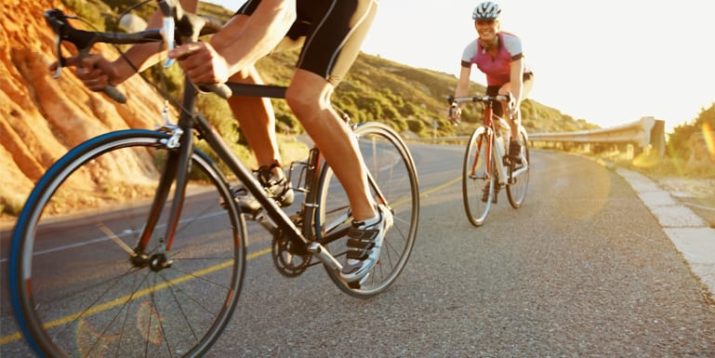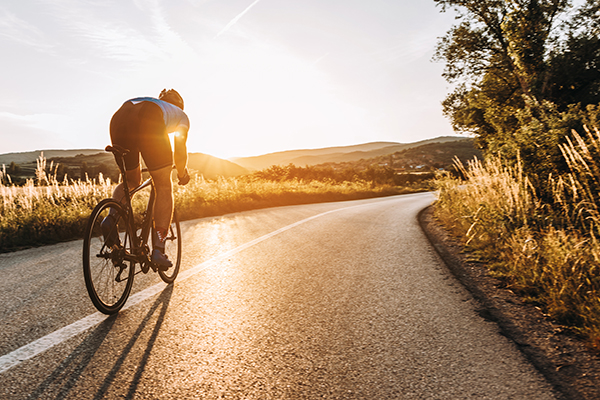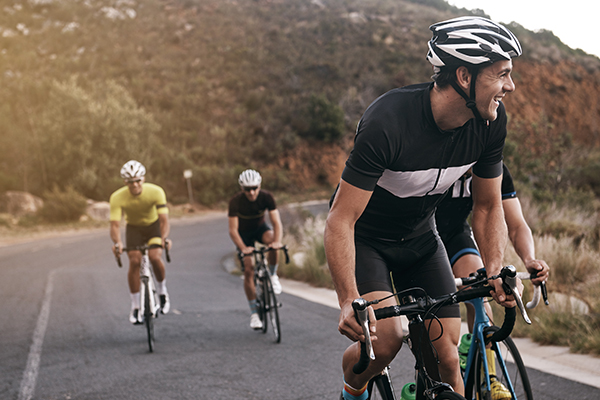4 Cycling Workouts to Help You Get Faster

Serious cyclists are creatures of habit. We religiously get up before sunrise, hit the head, chug a cup of joe, throw on our kit, and head out for a group ride.
The route and pace are almost always the same: Twenty to 40 miles (longer on weekends) at a pace that works up a sweat but doesn’t interfere with friendly conversations and griping about cars.
But if you’re only logging miles and not incorporating different cycling workouts into your routine, you’ll never reach your full athletic potential.
Whether you ride to race or simply to improve overall fitness, that congenial morning coffee ride occasionally needs to be turned into a double espresso, handlebar-chewing throw down.
“No matter what your talent or goal, the path to improvement always involves changing things up,” says Ron Peterson, a USA Cycling certified coach and owner of Peterson Training, in Redondo Beach, California. “When you constantly stress your body the same way, it eventually stops adapting and progress stagnates.”
The four cycling workouts in this article will help prevent that from happening.
In addition to injecting critical variety into your training program, each type of workout — from a one-hour tempo ride to a 30-minute interval session — will help you develop a different skill that can help you not only nail a new PR but also build a leaner, faster, more powerful body.
But first things first — before you jump into the workouts, you need to figure out two key variables: Your training objective and the training intensity that will guide each workout.
STEP 1: Identify Your Goal

Are you riding to become a stronger competitor or to improve overall fitness?
The answer to that question will determine how often you perform each type of cycling workout detailed in Step 3 (long slow distance, tempo, sweet spot, and short interval).
“Whether it’s a road race, gran fondo, century, bike tour, or dropping 15 pounds by your next birthday — set a goal that can be marked down on a calendar,” says Peterson. Then give yourself at least four months to achieve it.
If your goal is to improve fitness … During your first two months, do a couple of long slow distance rides each week along with a tempo workout and a couple of strength training sessions (yes, even endurance-minded folks should pump iron).
In month three, swap a weekly strength session for a sweet spot workout.
In month four, change things up even more: Do one tempo ride, one sweet spot workout, one short interval session, one long-distance ride, and one strength-training workout each week.
If your goal is to become a stronger competitor … During your first two months of your off-season, focus on building your base — a couple of two-hour rides and one or two strength training sessions during the week, and a couple of three-hour rides on weekends (or longer if you don’t have to take your kid to an afternoon soccer game).
In month three, start tailoring your training to your cycling niche. Climbers should aim for two sweet spot workouts and two recovery (read: easy long slow distance) rides each week, adding a short interval workout to the mix when you’re four weeks out from race day. Sprinters should focus on speed work.
Do two short-interval workouts per week, along with one tempo or sweet spot workout, and two recovery rides.
Both groups should also continue to do at least one strength training session per week.
Step 2: Test Yourself

To perform your workouts effectively, you’ll need to determine one of two key training metrics for gauging exercise intensity: Lactate threshold heart rate (LTHR) or functional threshold power (FTP).
Contrary to popular belief, lactate (sometimes referred to mistakenly as “lactic acid”) isn’t the cause of that deep muscle burn you feel late in a race or toward the end of a grueling workout.
It’s a buffering agent that helps neutralize the hydrogen ions that accumulate in muscles during aerobic (oxygen-fueled) energy production. The buildup of those ions is what causes acidosis (aka, “the burn”).
Your lactate threshold is the point at which you begin producing more hydrogen ions than you can effectively neutralize, and your LTHR represents the exercise intensity (in beats per minute) that will cause you to reach that point.
Threshold power is essentially the same “point of no return,” but it’s identified in watts instead of beats per minute. The maximum power that a cyclist can sustain for one hour is his or her FTP.
To determine your LTHR you’ll need a heart rate monitor, preferably in the form of a chest strap, which is typically more accurate than a wrist-based biometric sensor (i.e., the kind integrated into a watch).
To determine FTP you’ll need a power meter, which attaches to your bike. You can use either metric (LTHR or FTP) to gauge exercise intensity, but elite cyclists generally prefer FTP because it tends to be more accurate.
But whichever metric you choose, the test remains the same: Pop your bike in a trainer or find a stretch of road with a slight uphill and no stops that takes at least 30 minutes to ascend.
Warm up for 15 minutes at an easy pace, and then ride for 30 minutes at a pace that challenges you to complete the ride.
If you’re wearing a heart rate monitor, average your heart rate from the final 20 minutes to determine your LTHR.
If you’re using a power meter, average your power from the full 30 minutes, and then multiply that number by .95 to determine your FTP.
Re-test yourself every three weeks — as you become fitter, your LTHR and FTP will inch higher.
Step 3: Begin Training

You’ve determined your goal, identified a training plan, and figured out your LTHR or FTP. Now the fun begins!
Add the following four cycling workouts to your training schedule as described in Step 1.
Workout 1: Long Slow Distance
Intensity: 65 to 84 percent of LTHR, 55 to 75 percent of FTP
Duration: Two to three hours
Purpose: To develop raw endurance
The first phase of any smart periodized training plan (i.e., one divided into blocks that focus on specific goals or skills) is to build or reinforce a strong aerobic base.
So regardless of whether you’re a noob or a veteran, you’re going to spend a couple of months doing “long slow distance” (LSD), also commonly referred to as “foundation” or “base” miles.
“The goal is to increase the amount of work your body can do before becoming fatigued,” says Peterson. “You’re teaching your body to use fat [instead of glucose] as its go-to fuel source, and that’s huge.”
“Huge” because, for all intents and purposes, your body has an almost limitless supply of fat — even if you’re an elite competitor.
That makes it a preferable fuel to glucose, which is easier to burn, but stored in more limited quantities.
But to access fat as fuel, and to teach your body to burn blubber more efficiently, your heart rate needs to stay out of the red (lactate threshold) zone.
“Keep your pace ‘conversational’,” advises Peterson. If you find it difficult to speak more than a sentence or two at a time, dial it back.
You should be peddling hard enough to work up a sweat, but not so hard that talking becomes difficult.
Workout 2: Tempo Ride

Intensity: 85 to 91 percent of LTHR, 75 to 84 percent of FTP
Duration: One hour
Purpose: To increase your capacity for high-intensity effort (i.e., go harder for longer)
Often described as “sustainable discomfort,” tempo pace is the hardest intensity you can sustain for one hour while remaining “aerobic” (i.e., producing energy from glucose or fat in the presence of oxygen).
The goal is to condition your body to perform for prolonged periods at intensities that approach your lactate threshold.
Although beneficial during any phase of training, tempo rides are particularly important toward the end of the base-building phase, says Peterson, as they help prepare your body for the transition from straight LSD to training that includes shorter, harder speed work (i.e., intervals).
You can either do a tempo session at the end of an LSD ride (simply ramp up your pace during the last hour) or perform a dedicated, hour-long tempo workout.
Either way, it’s important that you perform the ride with as few interruptions as possible. You’re teaching your body to sustain high-intensity effort; this is no time to rest.
Workout 3: Sweet Spot Training
Intensity: 91 to 95 percent of LTHR, 85 to 90 percent of FTP
Duration: About an hour
Purpose: To increase both endurance and functional threshold power
Efforts between tempo pace and lactate threshold fall into what coaches refer to as the “sweet spot,” as training in this zone (usually in the form of long intervals) provides an ideal balance of intensity and volume for increasing that most critical of performance metrics: functional threshold power.
In short, sweet spot training (SST) helps increase the speed and power you can sustain during high-intensity exercise.
“I am a big fan of the sweet spot,” says Peterson. “You get a lot of bang for your buck, and it’s nowhere near as fatiguing as training at threshold.”
Pick a stretch of road that’s flat or has a steady 3 to 5 percent grade. Do three 15-minute intervals at the intensity mentioned above, recovering at an easy cadence for seven to eight minutes between each one.
“The interval pace should be hard enough so that talking becomes nearly impossible,” says Peterson. “About 10 beats below your threshold heart rate.”
Workout 4: Short Intervals
Intensity: 95 to 105 percent of LTHR, 91 to 120 percent of FTP
Duration: 30 Minutes
Purpose: To improve aerobic capacity, cellular energy production, power generation, endurance, stamina (exercise tolerance), and speed
Welcome to the red zone. For this workout, you’re going to exercise above your lactate threshold, and it’s going to burn like hell.
Most cyclists can only peddle for five-minute stretches at the intensity required for these intervals, and then kaboom — out go the lights.
But the pain is worth the payoff: New riders can improve their VO2-max (the maximum amount of oxygen their bodies can utilize during intense efforts), and experienced riders can boost their power and speed when operating at their lactate threshold.
What’s more, all levels of cyclists can improve endurance. Indeed, short, intense interval workouts can increase raw endurance just as much as long-distance rides, according to a study in the Journal of Physiology.
If your primary goal is to lose weight, the benefits of interval training are just as enticing, as research shows it can it help you lose more body fat than with steady-state cardio.
So how do you go about reaping these rewards?
Perform two to four intervals, each of which should encompass four minutes of hard effort (at the intensity mentioned above) and four minutes of “active rest,” during which you bring your cadence down to that of a leisurely ride.
“You’ll get the greatest benefit if you peddle as hard as you can, recover, and then do the next one just as hard,” says Peterson. In short, don’t skimp on rest.
If you don’t recover sufficiently between intervals, your “training effect” (i.e., your adaptations from exercise) will be diminished.
Indeed, being smart about how you perform each workout is just as important as incorporating all of them into your training program.
